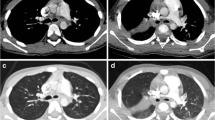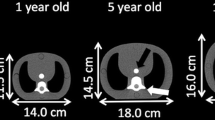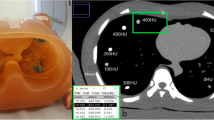Abstract
Background
A practical body-size adaptive protocol providing uniform image noise at various kV levels is not available for pediatric CT.
Objective
To develop a practical contrast-enhanced pediatric chest CT protocol providing uniform image noise by using an individualized volume CT dose index (CTDIvol) determined by the cross-sectional area and density of the body at variable kV levels and with combined tube current modulation.
Materials and methods
A total of 137 patients (mean age, 7.6 years) underwent contrast-enhanced pediatric chest CT based on body weight. From the CTDIvol, image noise, and area and mean density of the cross-section at the lung base in the weight-based group, the best fit equation was estimated with a very high correlation coefficient (γ2 = 0.86, P < 0.001). For the next study, 177 patients (mean age, 7.9 years; the CTDIvol group) underwent contrast-enhanced pediatric chest CT with the CTDIvol determined individually by the best fit equation. CTDIvol values on the dose report after CT scanning, noise differences from the target noise, areas, and mean densities were compared between these two groups.
Results
The CTDIvol values (mean±standard deviation, 1.6 ± 0.7 mGy) and the noise differences from the target noise (1.1 ± 0.9 HU) of the CTDIvol group were significantly lower than those of the weight-based group (2.0 ± 1.0 mGy, 1.8 ± 1.4 HU) (P < 0.001). In contrast, no statistically significant difference was found in area (317.0 ± 136.8 cm2 vs. 326.3 ± 124.8 cm2), mean density (−212.9 ± 53.1 HU vs. −221.1 ± 56.3 HU), and image noise (13.8 ± 2.3 vs. 13.6 ± 1.7 HU) between the weight-based and the CTDIvol groups (P > 0.05).
Conclusion
Contrast-enhanced pediatric chest CT with the CTDIvol determined individually by the cross-sectional area and density of the body provides more uniform noise and better dose adaptation to body habitus than does weight-based CT at variable kV levels and with combined tube current modulation.



Similar content being viewed by others
References
Kalra MK, Maher MM, Toth TL et al (2004) Strategies for CT radiation dose optimization. Radiology 230:619–628
Goo HW (2005) Pediatric CT: understanding of radiation dose and optimization of imaging techniques. J Korean Radiol Soc 52:1–5
Yang DH, Goo HW (2008) Pediatric 16-slice CT protocols: radiation dose and image quality. J Korean Radiol Soc 59:333–347
Singh S, Kalra MK, Moore MA et al (2009) Dose reduction and compliance with pediatric CT protocols adapted to patient size, clinical indication, and number of prior studies. Radiology 252:200–208
Stark G, Lonn L, Cederblad A et al (2002) A method to obtain the same levels of CT image noise for patients with various sizes, to minimize radiation dose. Br J Radiol 75:140–150
Boone JM, Geraphty EM, Seibert JA et al (2003) Dose reduction in pediatric CT: a rational approach. Radiology 228:352–360
Kalra MK, Maher MM, Prasad SR et al (2003) Correlation of patient weight and cross-sectional dimensions with subjective image quality at standard dose abdominal CT. Korean J Radiol 4:234–238
Jung YY, Goo HW (2008) The optimal parameter for radiation dose in pediatric low dose abdominal CT: cross-sectional dimensions versus body weight. J Korean Radiol Soc 58:169–175
Nyman U, Ahl TL, Kristiansson M et al (2005) Patient-circumference-adapted dose regulation in body computed tomography. A practical and flexible formula. Acta Radiol 46:396–406
Menke J (2005) Comparison of different body size parameters for individual dose adaptation in body CT of adults. Radiology 236:565–571
Irie T, Inoue H (2005) Individual modulation of the tube current-seconds to achieve similar levels of image noise in contrast-enhanced abdominal CT. AJR Am J Roentgenol 184:1514–1518
Hur G, Hong SW, Kim SY et al (2007) Uniform image quality achieved by tube current modulation using SD of attenuation in coronary CT angiography. AJR Am J Roentgenol 189:188–196
Goo HW, Suh DS (2006) Tube current reduction in pediatric non-ECG-gated heart CT by combined tube current modulation. Pediatr Radiol 36:344–351
Goo HW, Suh DS (2006) The influences of tube voltage and scan direction on combined tube current modulation: a phantom study. Pediatr Radiol 36:833–840
Schindera ST, Nelson RC, Toth TL et al (2008) Effect of patient size on radiation dose for abdominal MDCT with automatic tube current modulation: phantom study. AJR Am J Roentgenol 190:W100–W105
McCollough CH (2005) Automatic exposure control in CT: are we done yet? Radiology 237:755–756
Nagel MG, Stamm G. Paediatric CT exposure practice in the federal republic of Germany: results of a nation-wide survey in 2005/06. Hannover: Hannover Medical School. 2006. Available from URL : http://www.mh-hannover.de/fileadmin/kliniken/diagnostische_radiologie/download/Report_German_Paed-CT-Survey_2005_06.pdf
Prakash P, Kalra MK, Gilman MD et al (2010) Is weight-based adjustment of automatic exposure control necessary for the reduction of chest CT radiation dose? Korean J Radiol 11:46–53
Watanabe H, Kanematsu M, Miyoshi T et al (2010) Improvement of image quality of low radiation dose abdominal CT by increasing contrast enhancement. AJR Am J Roentgenol 195:986–992
Yu L, Li H, Fletcher JG et al (2010) Automatic selection of tube potential for radiation dose reduction in CT: a general strategy. Med Phys 37:234–243
Author information
Authors and Affiliations
Corresponding author
Rights and permissions
About this article
Cite this article
Goo, H.W. Individualized volume CT dose index determined by cross-sectional area and mean density of the body to achieve uniform image noise of contrast-enhanced pediatric chest CT obtained at variable kV levels and with combined tube current modulation. Pediatr Radiol 41, 839–847 (2011). https://doi.org/10.1007/s00247-011-2121-4
Received:
Revised:
Accepted:
Published:
Issue Date:
DOI: https://doi.org/10.1007/s00247-011-2121-4




